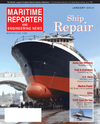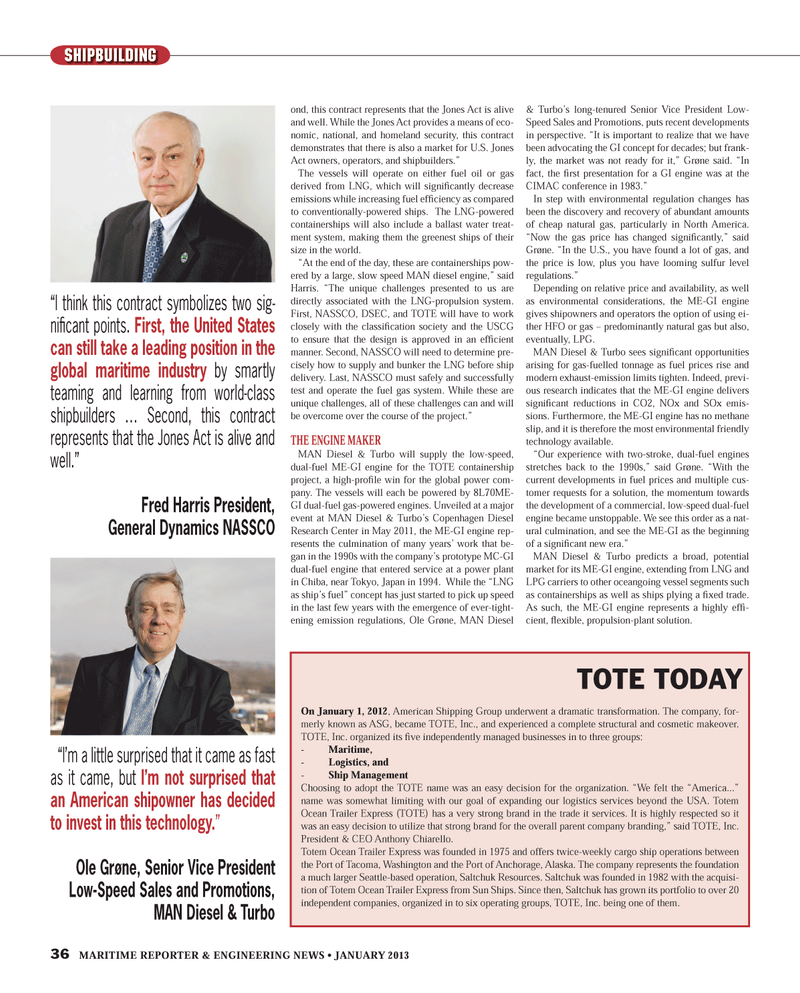
Page 36: of Maritime Reporter Magazine (January 2013)
Ship Repair & Conversion
Read this page in Pdf, Flash or Html5 edition of January 2013 Maritime Reporter Magazine
36 MARITIME REPORTER & ENGINEERING NEWS ? JANUARY 2013 SHIPBUILDINGond, this contract represents that the Jones Act is alive and well. While the Jones Act provides a means of eco- nomic, national, and homeland security, this contract demonstrates that there is also a market for U.S. Jones Act owners, operators, and shipbuilders.?The vessels will operate on either fuel oil or gas derived from LNG, which will signiÞ cantly decrease emissions while increasing fuel efÞ ciency as compared to conventionally-powered ships. The LNG-powered containerships will also include a ballast water treat-ment system, making them the greenest ships of their size in the world. ?At the end of the day, these are containerships pow- ered by a large, slow speed MAN diesel engine,? said Harris. ?The unique challenges presented to us are directly associated with the LNG-propulsion system. First, NASSCO, DSEC, and TOTE will have to work closely with the classiÞ cation society and the USCG to ensure that the design is approved in an efÞ cient manner. Second, NASSCO will need to determine pre- cisely how to supply and bunker the LNG before ship delivery. Last, NASSCO must safely and successfully test and operate the fuel gas system. While these are unique challenges, all of these challenges can and will be overcome over the course of the project.?THE ENGINE MAKERMAN Diesel & Turbo will supply the low-speed, dual-fuel ME-GI engine for the TOTE containership project, a high-proÞ le win for the global power com- pany. The vessels will each be powered by 8L70ME- GI dual-fuel gas-powered engines. Unveiled at a major event at MAN Diesel & Turbo?s Copenhagen Diesel Research Center in May 2011, the ME-GI engine rep- resents the culmination of many years? work that be- gan in the 1990s with the company?s prototype MC-GI dual-fuel engine that entered service at a power plant in Chiba, near Tokyo, Japan in 1994. While the ?LNG as ship?s fuel? concept has just started to pick up speed in the last few years with the emergence of ever-tight- ening emission regulations, Ole Grøne, MAN Diesel & Turbo?s long-tenured Senior Vice President Low- Speed Sales and Promotions, puts recent developments in perspective. ?It is important to realize that we have been advocating the GI concept for decades; but frank-ly, the market was not ready for it,? Grøne said. ?In fact, the Þ rst presentation for a GI engine was at the CIMAC conference in 1983.?In step with environmental regulation changes has been the discovery and recovery of abundant amounts of cheap natural gas, particularly in North America. ?Now the gas price has changed signiÞ cantly,? said Grøne. ?In the U.S., you have found a lot of gas, and the price is low, plus you have looming sulfur level regulations.?Depending on relative price and availability, as well as environmental considerations, the ME-GI engine gives shipowners and operators the option of using ei-ther HFO or gas ? predominantly natural gas but also, eventually, LPG. MAN Diesel & Turbo sees signi Þ cant opportunities arising for gas-fuelled tonnage as fuel prices rise and modern exhaust-emission limits tighten. Indeed, previ-ous research indicates that the ME-GI engine delivers signiÞ cant reductions in CO2, NOx and SOx emis- sions. Furthermore, the ME-GI engine has no methane slip, and it is therefore the most environmental friendly technology available.?Our experience with two-stroke, dual-fuel engines stretches back to the 1990s,? said Grøne. ?With the current developments in fuel prices and multiple cus-tomer requests for a solution, the momentum towards the development of a commercial, low-speed dual-fuel engine became unstoppable. We see this order as a nat- ural culmination, and see the ME-GI as the beginning of a signiÞ cant new era.? MAN Diesel & Turbo predicts a broad, potential market for its ME-GI engine, extending from LNG and LPG carriers to other oceangoing vessel segments such as containerships as well as ships plying a Þ xed trade. As such, the ME-GI engine represents a highly efÞ -cient, ß exible, propulsion-plant solution. ?I think this contract symbolizes two sig-ni cant points. First, the United States can still take a leading position in the global maritime industry by smartly teaming and learning from world-class shipbuilders ? Second, this contract represents that the Jones Act is alive and well.?Fred Harris President, General Dynamics NASSCO?I?m a little surprised that it came as fast as it came, but I?m not surprised that an American shipowner has decided to invest in this technology.?Ole Grøne, Senior Vice President Low-Speed Sales and Promotions, MAN Diesel & Turbo TOTE TODAY On January 1, 2012, American Shipping Group underwent a dramatic transformation. The company, for- merly known as ASG, became TOTE, Inc., and experienced a complete structural and cosmetic makeover. TOTE, Inc. organized its Þ ve independently managed businesses in to three groups: - Maritime, - Logistics, and - Ship Management Choosing to adopt the TOTE name was an easy decision for the organization. ?We felt the ?America...? name was somewhat limiting with our goal of expanding our logistics services beyond the USA. Totem Ocean Trailer Express (TOTE) has a very strong brand in the trade it services. It is highly respected so it was an easy decision to utilize that strong brand for the overall parent company branding,? said TOTE, Inc. President & CEO Anthony Chiarello. Totem Ocean Trailer Express was founded in 1975 and offers twice-weekly cargo ship operations between the Port of Tacoma, Washington and the Port of Anchorage, Alaska. The company represents the foundation a much larger Seattle-based operation, Saltchuk Resources. Saltchuk was founded in 1982 with the acquisi- tion of Totem Ocean Trailer Express from Sun Ships. Since then, Saltchuk has grown its portfolio to over 20 independent companies, organized in to six operating groups, TOTE, Inc. being one of them. MR #1 (34-41).indd 36MR #1 (34-41).indd 361/2/2013 1:14:30 PM1/2/2013 1:14:30 PM

 35
35

 37
37
